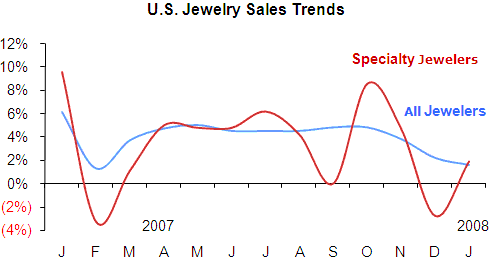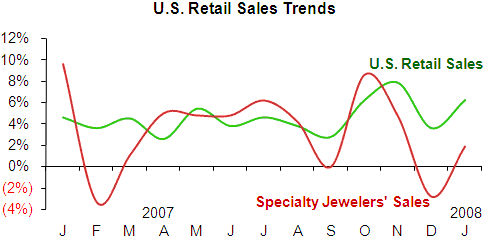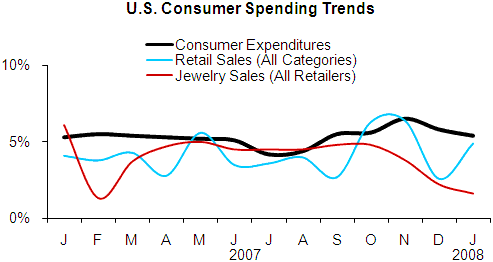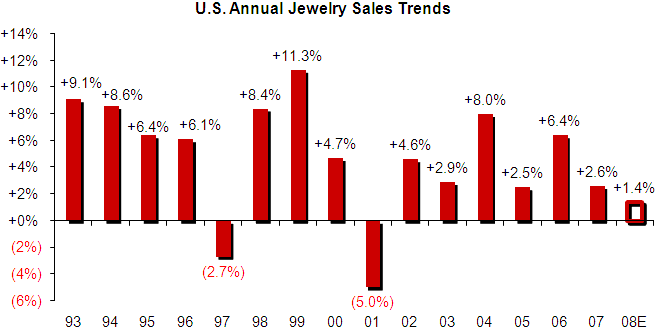IDEX Online Research: U.S. Jewelry Sales Creep Upward in January
March 17, 08
Specialty jewelers in the U.S. market posted a very modest sales gain in January – +1.9 percent over the same month a year ago – according to the U.S. Department of Commerce. Total jewelry sales – sales of jewelry in all retail outlets which sell this merchandise category – were up 1.6 percent in January. Thus, while jewelry demand was weak during the month, specialty jewelers gained market share from non-traditional jewelry outlets such as discounters and others.
Further, as expected, the Department of Commerce revised December 2007 jewelry sales levels downward, though not by as much as we would have expected. Based on the newly revised data, December 2007 specialty jewelers’ sales in the U.S. market fell by 2.8 percent; preliminary data had indicated a decline of 2.6 percent.
Total U.S. jewelry sales data was modestly revised for 2007; it now appears that jewelry sales in America were up 4.2 percent in 2007, down slightly from the previously reported gain of 4.3 percent. The Commerce Department will continue to recalculate this number each month until about mid-year; we do not expect any significant change from current levels.
The Commerce Department also scaled back the previously reported preliminary retail sales gains (all categories) for the final quarter of the year (see Scoreboard below).
 Source: Various |
Jewelers’ Sales Mixed
When asked how business is, most U.S. jewelers use words like “dismal,” “weak,” “disappointing,” and other negative adjectives. However, based on our sample of jewelers, those with the weakest sales are also the most vocal. On the other hand, jewelers who are posting sales gains – some at double-digit levels – have been very quiet about their performance for two reasons: 1) they don’t want their “luck” to change by talking about how well they are doing in a weak environment; and/or 2) they are doing well because they have created a competitive differential that they don’t want the rest of the industry to copy.
What are the secrets of those successful jewelers? There are some common threads in how they do their business. First, they are in the “business of jewelry” versus the “jewelry business.” That is, they use relatively sophisticated management information systems to track sales and margins, rather than relying on their intuition or some other qualitative factors to track their performance. The successful jewelers review their results weekly (or more frequently), looking for trends that will point to future successes. They don’t go home at night wringing their hands, because they know what’s going on in their business. Too many merchants are in the “jewelry business” because they like precious metals and gemstones; that helps, but it is not a recipe for success.
What categories are selling for those jewelers who are bucking the trend?
- Brands
- Fashion
- Designer names
- Unique designs
- Custom
The successful jewelers also report that rather than selling a new larger diamond, customers are seeking to have estate jewelry reworked. Some are asking for older jewelry to be updated. Big ticket sales are fewer, but for those jewelers who offer something unique, business remains steady.
Outlook Cautious
As expected, our outlook for U.S. jewelry sales remains cautious for the first half of the year. Whether or not we are in a “technical recession” – defined as two consecutive quarters of a decline in Gross Domestic Product – or just in a “mental recession” with consumers tightening their purse strings, the fact is this: retail spending is slowing.
Jewelry is often cited as a category which softens first in a recession and recovers last. In the current environment, jewelry sales have remained strong much longer than expected. They are still holding up better than predicted. We can only hope these trends hold, and perhaps lead to a solid recovery in the all-important 2008 holiday selling season.
January Jewelry Sales Show Modest Gain
During the month of January 2008, specialty jewelers in the U.S. market posted a preliminary sales gain of 1.9 percent over the same month a year ago. The total market for jewelry grew by about 1.6 percent during January. Thus, specialty jewelers posted a slight gain in market share versus their competition from non-traditional sources of jewelry such as discounters, mass marketers, and others.
However, the jewelry industry lost market share to other retail categories. Total retail sales (all goods, including food and automobiles), were up 4.9 percent in January. It is no surprise that jewelry lost market share, since it is a discretionary item. The current recessionary environment is having a negative impact on demand for discretionary goods, especially big ticket infrequently purchased merchandise such as furniture, homes and automobiles.
 Source: Department of Commerce |
The graph below summarizes sales trends for all retail goods (green line) excluding food and automobiles versus specialty jewelers’ sales (red line). When food and auto sales are excluded, the remaining retail categories posted a sales gain of 6.2 percent in January. When food and auto sales are included, retail sales were up only 4.9 percent for the month, as previously indicated.
 Source: Department of Commerce |
Consumer Spending Perked Up in January
Driven by price inflation of core commodities such as gasoline and food, consumer expenditures rose by 5.4 percent during January 2008. Spending on services remained more-or-less on track, with little monthly deviation. However, overall consumer expenditure growth has slowed for the past two months (black line on graph below).
 Source: Department of Commerce |
Outlook: 2008 Will Be A Tough Year for Jewelers
When the economy slows, jewelry demand is elusive. When the economy grows, jewelry demand soars. That’s the simple formula for forecasting jewelry sales.
Most economists seem to think the U.S. is already in a recession. It could last two or three quarters, and a recovery could begin in the third or fourth quarter of the year. If all goes well, the economy should be showing solid signs of growth in the all-important fourth quarter of 2008. The good news is that the U.S. Fed is trying to engineer a soft landing, though it may be too late.
The better news is that the tax rebate which most consumers will be large enough to purchase a nice piece of jewelry. According to the Internal Revenue Service (IRS), most individuals will receive up to $600 (up to $1,200 for married couples), and parents will receive an additional $300 for each child under 17 years old, though there are some limitations on the rebate.
At this point, we haven’t published our official 2008 jewelry sales forecast. Currently, our very preliminary sales forecast for the U.S. jewelry industry calls for total industry sales to be up by 2 percent or so for the full year, though this range appears to be optimistic. This reflects a modest decline in unit sales, offset by continued rising price inflation. Unfortunately, specialty jewelers’ sales are expected to lag total industry growth slightly.
The graph below summarizes our “mathematical forecast” for 2008 jewelry sales; it calls for a sales gain of about 1.4 percent. While the algorithms which produce this forecast have been fine-tuned, we still believe that our “human element” is important in any forecast. None-the-less, it is interesting that the “math” forecast – +1.4 percent – and our preliminary IDEX Online forecast – +2 percent – seem to be very close, at this point.
 Source: Department of Commerce & IDEX Online Research |